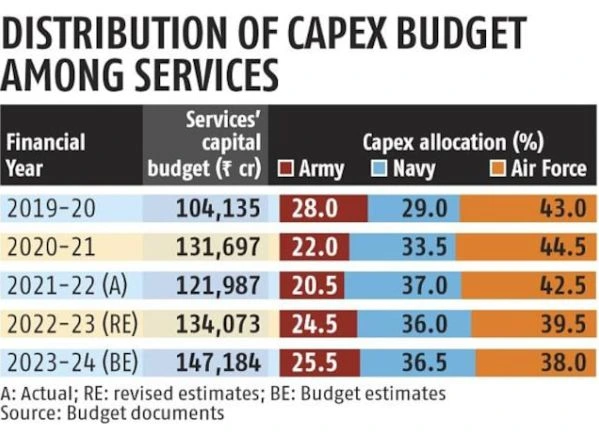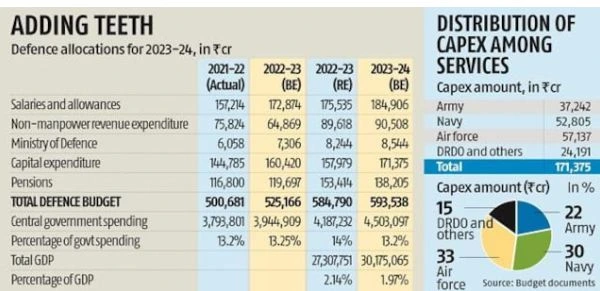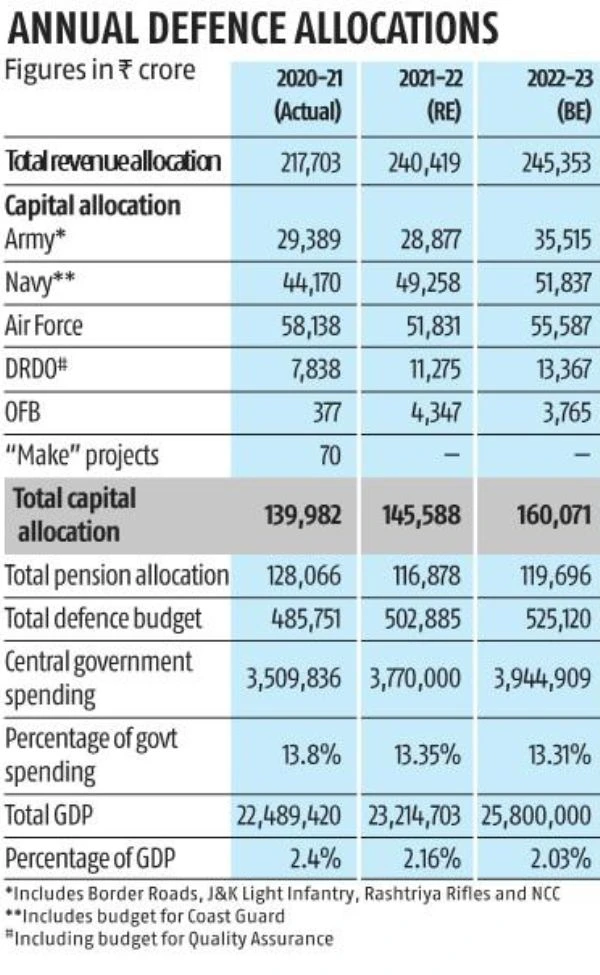Defence Allocated 13.18% of Total Budget
The Union Budget for Financial Year 2023-24 envisages a total outlay of Rs 45,03,097 crore. Of this, Ministry of Defence has been allocated a total Budget of Rs 5,93,537.64 crore, which is 13.18 % of the total budget. This includes an amount of Rs 1,38,205 crore for Defence Pensions. The total Defence Budget represents an enhancement of Rs 68,371.49 crore (13%) over the Budget of 2022-23.
The non-salary portion of the revenue outlay has been enhanced by 44 per cent from Rs 64,869 crore in the budget estimates for 2022-23; to just over Rs 90,000 crore in the coming year.
But, for the first time in decades, India’s defence allocations have dropped below two per cent of the nominal Gross Domestic Product (GDP). It stands at 1.97 per cent of GDP, or 13.2 per cent of government spending.
The defence allocations for 2023-24 represent an enhancement of Rs 68,371 crore, or 13 per cent, over the budget allocations of 2022-23. However, if this year’s allocations are compared with the revised allocations of 2022-23, the rise is a miniscule 1.5 per cent.
The government expects to close critical gaps in the combat capabilities and equip the forces in terms of ammunition, sustenance of weapons & assets, military reserves etc.
Services Allocations
While the 1.3-million-strong army has been allocated a lion’s share of the revenue and pension budgets, the Indian Air Force has got the biggest share of the capital allocation: Rs 57,137 crore. The navy has been allocated Rs 52,805 crore, while the army will make do with the smallest capital budget: Rs 37,242 crore.
Capital Expenditure
The defence capital outlay for equipment modernisation and infrastructure development has increased to Rs 171,375 crore.
MoD pointed to the steady rise in the defence capital outlay from Rs 86,740 crore in 2013-14 to 1.52 lakh crore in 2022-23 – an enhancement of 76 per cent over a period of nine years. While that sounds like a healthy growth rate, it actually amounts to less than 5 per cent, compounded annually – barely enough to cater for inflation and foreign exchange rate variation.
The Indian Navy has received a significant rise in its capital allocation In a long-overdue recognition of the importance of maritime security. The navy’s capital budget has been enhanced by about 43 per cent, from an allocation of Rs 33,254 crore in FY 2021-22 to Rs 47,591 crore in FY 2022-23, a rise of Rs 14,337 crore. This increment will be needed to support the acquisition of new platforms, such as six air-independent propulsion (AIP) submarines being acquired under Project 75-I, a second indigenous aircraft carrier (IAC-2), 57 twin-engine deck-based fighters (TEDBFs) and four more P-8I Poseidon long-range maritime patrol aircraft to keep a watch over the Indian Ocean. The navy is also creating operational and strategic infrastructure that will be needed when the tri-service maritime command is operationalised in Karwar, near Goa.
The capital budget of the Indian Coast Guard (which operates under the navy for coastal security in peace and for operations in wartime and forms a part of the defence ministry budget) has been enhanced from Rs 2,650 crore in FY 2021-22, by over 60 per cent to Rs 4,246 crore in FY 2022-23. This will provide the wherewithal needed for building up assets such as offshore patrol vessels, maritime reconnaissance ships and aircraft, establishment of a coastal security network and building up technical and administrative support structures.


Border Infrastructure
The capital allocation to the Border Roads Organisation (BRO) has been increased by 43 per cent, from Rs 3,500 crore in FY 2022-23 to to Rs 5,000 crore in FY 2023-24. The defence ministry says the BRO’s allocation had doubled in the two years since FY 2021-22.
“This will boost border infrastructure, thereby creating strategically important assets like Sela Tunnel, Nechiphu Tunnel and the Sela-Chhabrela Tunnel,” said the defence ministry in a press release.
In 2021, BRO executed a record 102 roads and bridges at extreme altitudes and weather conditions. This includes the world’s highest motorable road at Umling La, at an altitude of 19,024 feet.
Research & Development
Towards strengthening Research and Development in Defence, the allocation to DRDO has been enhanced by 9%, with a total allocation of Rs 23,264 crore in BE 2023-24.
25 per cent of the DRDO budget has been earmarked for engagement of industry, startups and academia. The DRDO’s capital budget allocation is up 5.3 per cent from Rs 11,375 crore in BE 2021-22 to Rs 11,981 crore in the current year, providing only a limited boost to indigenous R&D projects.
Currently, the DRDO engages about 20,000 industries of various sizes in the development of various systems, sub-systems and technologies, directly and indirectly. Through its Technology Development Fund (TDF) scheme, DRDO extends financial support to Indian MSMEs and startups for indigenous design and development of defence products, components and subsystems. The fund is utilized for developing new technologies as required by DRDO, services, and DPSUs.
DRDO also works with more than 250 academic institutes on different defence R&D problems for basic, applied and targeted research. It has established 10 advanced research centres in various academic institutions.
MSMEs
The Union Budget 2023-24 has also announced that the revamped Credit Guarantee scheme for MSMEs which will take effect from 1st April 2023 through infusion of Rs. 9,000 Crore in the corpus. This will enable additional collateral-free guaranteed credit of Rs 2 lakh crore. Further, the cost of the credit has also been reduced by about 1 per cent. This scheme will give a further fillip the MSMEs associated with the Defence Sector.
Innovation
To further foster innovation, encourage technology development and strengthen the Defence Industrial ecosystem in the country, iDEX and DTIS have been allocated Rs 116 crore and Rs 45 crore respectively representing an enhancement of 93% for iDEX and 95% for DTIS over 2022-23. This will fulfill the Ministry of Defence’s vision to leverage ideas from bright young minds across the country.
The Union Budget 2023-24 has announced a National Data Governance Policy to unleash innovation and research by start-ups and academia. This will enable access to anonymized data which will further boost the Defence Start-ups and iDEX scheme.


DPSUs
Seven new Defence Public Sector Undertakings (DPSUs) were created as a result of the “corporatisation” of the Ordnance Factories. This required earmarking a sum of Rs 1,665 crore in Revised Estimates (RE) of 2021-22 and Rs 1,310 crore in Budget Estimates (BE) 2022-23 for their planned modernisation. Additionally, Rs 2,500 crore were set aside in BE 2022-23 and in RE 2021-22 as Emergency Authorization Fund.
Pensions & Welfare
The Defence Pension Budget registers a notable jump of 15.5 % in FY 2023-24. In absolute terms, this amount is Rs 1,38, 205 Crore in BE 2023-24 against Rs 1,19,696 crore in BE 2022-23. Further, RE 2022-23 allocations at Rs 1,53,415 crore records a significant jump of 28%, amounting to Rs 33, 718 crores. This includes an amount of Rs 28,138 Crore to meet the requirement on account of revision of Armed Forces Pensioners under OROP.
Towards the Government’s commitment in transforming Healthcare outreach to our veterans, Defence Budget 2023-24 registers a notable increase of 52% in the allotment for Ex-Servicemen Contributory Health Scheme (ECHS) with BE allocation of Rs. 5431.56 Crore in FY 2023-24 against Rs. 3582.51 Crore in FY 2022-23. This enhancement will ensure ‘Cashless Health Services’ and improved ‘Service Delivery’ to our veterans and their dependents across India.
Parliamentary Committee’s Recommendations
A Parliamentary Standing Committee on Defence has shown concern at the widening gap between projections and allocations in the defence budget. The Committee noted that since 2015-16, none of the three Services (Army, Navy and Air Force) has been given the matching allocation as per the projection. There is a considerable shortage in the allocation in the Capital Head, which is 35% less than the projection.
The Committee noted that committed liabilities constitute a significant part of the Capital Head and inadequate allocation would definitely lead to ‘default situation’ on contractual obligations. Committed liabilities are payments anticipated during a financial year for contracts concluded in previous years.
Such a situation is not conducive for preparation of the country to modern-day warfare, where possession of capital intensive modern machines is a prerequisite for tilting the result of the war in favour and also to have a credible deterrence.
Both the Navy and the Indian Air Force (IAF) have a situation where their committed liabilities are more than their share of the capital allocation in the Budget.
To offset this, the Services have been forced to defer payment of committed liabilities of the Defence Public Sector Undertakings (DPSU) among other measures.
The shortfall in expenditure will affect:
• Operationalisation of three tri-service organizations i.e. Defence Space Agency (DSA), Defence Cyber Agency (DCYA) and Armed Forces Special Operations Division (AFSOD).
• Operational readiness of Andaman and Nicobar Command (ANC).
• Maintenance of SIGINT (Signal Intelligence) equipment.
• Administration of training institutes and operational units.
The committee has recommended a dedicated fund for committed liabilities and procurements before the shortfall impacts modernisation, invariably from next Budget onwards (2021-22).
Push to Indigenise Defence Equipment Since 2021
The total number of items, that were under an import ban, and used in tanks, infantry combat vehicles, missiles and warships, and have been indigenised including replacement units, subsystems and spares, indigenised in the last two-and-a-half years has risen to 2,736.
The ministry’s department of defence production has so far published four positive indigenisation lists of 4,666 items.
All these items were part of different positive indigenisation lists published by the defence ministry to cut the import dependence of defence public sector undertakings.
The indigenisation has been achieved by state-run firms either through industry partners, including micro, small and medium enterprises, or in-house.
The ministry’s department of defence production has so far published four positive indigenisation lists of 4,666 items including replacement units, subsystems, spares and components that have come under a phased import ban.
The components and subsystems include several items for fighter jets, Dornier-228 planes, multiple systems for submarines, equipment for T-90 and Arjun tanks, BMP-II infantry combat vehicles, warships and submarines, and anti-tank missiles.
India has employed a two-pronged approach to achieve indigenisation through import bans. One approach relates to banning the import of weapons and systems such as fighter jets, warships, helicopters and artillery guns, while the other covers subsystems, spares and components that are part of bigger weapon platforms.
As part of the former, India has published four other lists that have imposed a phased import ban on 411 different types of weapons and platforms including light weight tanks, naval utility helicopters, artillery guns, missiles, destroyers, ship-borne cruise missiles, light combat aircraft, light transport aircraft, long-range land-attack cruise missiles, basic trainer aircraft, airborne early warning and control systems, and multi-barrel rocket launchers.
These lists were announced in the past three years — in August 2020, May 2021, April 2022 and October 2022. Import substitution of ammunition, which is a recurring requirement, has been given special emphasis in these lists.
India has taken a raft of measures over the past 4-5 years to boost self-reliance in defence. Apart from a series of phased import bans, these steps include creating a separate budget for buying locally made military hardware and increasing foreign direct investment from 49% to 74%.
Defence indigenization has been extended to areas such as Innovations for Defence Excellence (idEX) which seeks to generate innovation in the aerospace and defence industry with the involvement of Micro, Small and Medium Enterprises (MSMEs), start-ups, Research and Development (R&D) institutes, individual entrepreneurs, and academia. The government has allocated almost 500 crores towards (idEX) for the period between 2021 and 2026. In addition, the government has launched the Supporting Pole-vaulting in R&D through Innovations for Defence Excellence (SPRINT), which requires development of very niche technologies in the space and naval domains. They are part of the Make-1 and Make-2 initiated under the Department for Defence Production (DDP) for idEX to encourage technology development though 75 challenges by enlisting the efforts of young technologists, start-ups and private companies in the space and naval domains to meet key requirements of the armed forces.













